5 Poisonous Frog Species
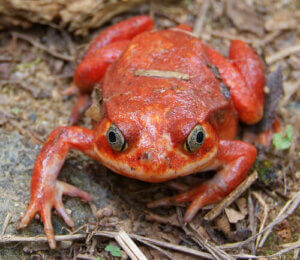
Amphibians have many glands on their skin, and in some species these glands produce poison. Many frogs and salamanders are poisonous in order to protect themselves from predators, but the ones listed below are very dangerous poisonous frog species:
What do poisonous frog species look like?
Many amphibians, not just frogs, have poison glands. But, in most species, these only make them taste bad to avoid predators seeing them as appetizing prey. However, there are a few poison frog species that are very dangerous even to humans.
Amphibians need a moist environment with water and land to live in. So, the natural habitat of many of these frogs is made up of the jungles of South and Central America. In general, they’re very small animals, measuring only an inch or two in length.
Another typical trait is their colors: their skin is bright and colorful to warn predators. This warning system works so well that there are other non-poisonous frogs that have developed bright colors to scare off predators.
1. Madagascar tomato frog
The Madagascar tomato frog –in the photo at the beginning of this article– is a species endemic to this large island whose name it bears, which means that it only lives in this habitat. It’s larger than the other frogs on this list, with females reaching 10 cm (4 in) in length and weighing around 200 grams (7 oz).
As its name suggests, it has a bright red color, and some specimens may have black spots under the chin. It’s not fatal to humans, but can cause severe stinging, pain, and allergic reactions.
2. Harlequin poison dart frog
The Harlequin poison dart frog is actually a family of almost 100 different frog species that range from Costa Rica to Bolivia. It has very bright colors and unlike many other species which are nocturnal, most of its activity takes place during the day.
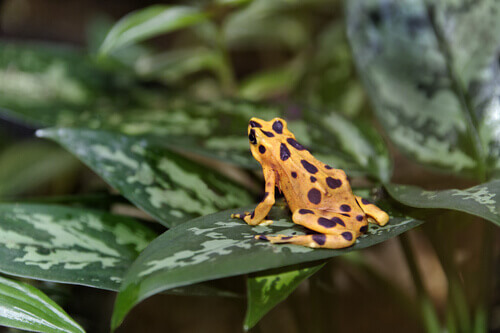
There is little information about the conservation status of these poison frog species. Some of these frogs are endangered, while others are thought to be extinct. Still, new species continue to be discovered from time to time.
3. Waxy monkey tree frog
The waxy monkey tree frog lives in trees in the Gran Chaco region between Argentina, Bolivia, and Paraguay. It rarely jumps, preferring to move slowly on the branches.
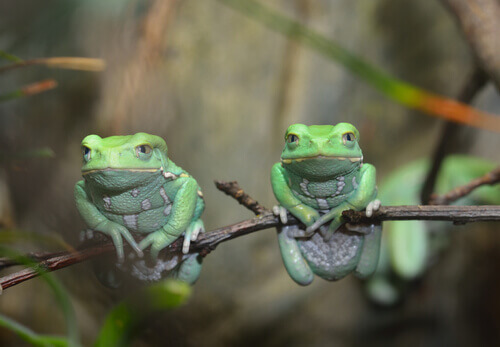
This is an example of an amphibian that, despite requiring a moist habitat, has adapted in order to only have to climb down for water very rarely. Its skin loses less moisture than that of other frogs because it moves so slowly. As such, this species spends as much time as possible in trees.
4. Blue poison dart frog
This poisonous frog lives in Suriname but spreads as far as Brazil, and is very small in size: between 40 and 50 mm (1.6 to 2 in). It’s an aggressive and territorial species, both with frogs of its own species and with other animals.
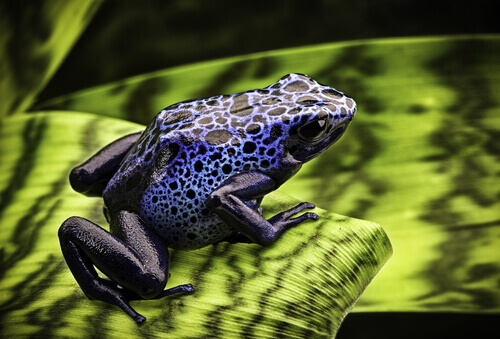
It’s also known as the “poison arrow frog” because it’s one of the poisonous frog species used by jungle natives to soak their arrowheads. It varies in color from blue to violet, and its black spots are unique to each specimen.
5. Golden poison frog: the most poisonous frog species in the world
The golden poison frog is closely related to the blue arrow frog, even if it lives on the coast of Colombia. It’s active during the day, and has a size between 60 and 70 mm (2.4 to 2.8 in).
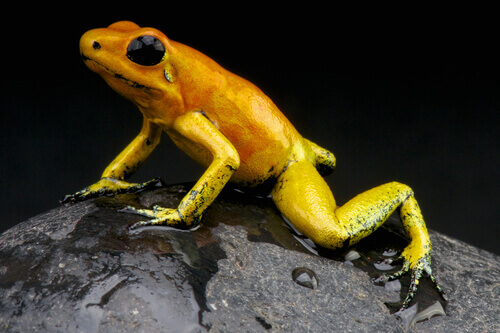
This species has three color variations: yellow, mint green, and orange. However, scientists generalize it saying it’s golden. It’s also the most poisonous animal in the world: one gram of its poison could kill thousands of human beings. The poison, moreover, remains active after the frog has secreted it.
Indigenous people also use them to poison darts or arrowheads. This poison remains active for almost two years after being placed on the arrow. However, in captivity, this frog is no longer toxic.
Almost all amphibians are poisonous as a protective measure against predators, but many of them aren’t dangerous to humans. As for poisonous frog species, we can say that they’re small and with bright colors in order to be visible. If you find such a frog, it’s best not to disturb it.
Amphibians have many glands on their skin, and in some species these glands produce poison. Many frogs and salamanders are poisonous in order to protect themselves from predators, but the ones listed below are very dangerous poisonous frog species:
What do poisonous frog species look like?
Many amphibians, not just frogs, have poison glands. But, in most species, these only make them taste bad to avoid predators seeing them as appetizing prey. However, there are a few poison frog species that are very dangerous even to humans.
Amphibians need a moist environment with water and land to live in. So, the natural habitat of many of these frogs is made up of the jungles of South and Central America. In general, they’re very small animals, measuring only an inch or two in length.
Another typical trait is their colors: their skin is bright and colorful to warn predators. This warning system works so well that there are other non-poisonous frogs that have developed bright colors to scare off predators.
1. Madagascar tomato frog
The Madagascar tomato frog –in the photo at the beginning of this article– is a species endemic to this large island whose name it bears, which means that it only lives in this habitat. It’s larger than the other frogs on this list, with females reaching 10 cm (4 in) in length and weighing around 200 grams (7 oz).
As its name suggests, it has a bright red color, and some specimens may have black spots under the chin. It’s not fatal to humans, but can cause severe stinging, pain, and allergic reactions.
2. Harlequin poison dart frog
The Harlequin poison dart frog is actually a family of almost 100 different frog species that range from Costa Rica to Bolivia. It has very bright colors and unlike many other species which are nocturnal, most of its activity takes place during the day.

There is little information about the conservation status of these poison frog species. Some of these frogs are endangered, while others are thought to be extinct. Still, new species continue to be discovered from time to time.
3. Waxy monkey tree frog
The waxy monkey tree frog lives in trees in the Gran Chaco region between Argentina, Bolivia, and Paraguay. It rarely jumps, preferring to move slowly on the branches.

This is an example of an amphibian that, despite requiring a moist habitat, has adapted in order to only have to climb down for water very rarely. Its skin loses less moisture than that of other frogs because it moves so slowly. As such, this species spends as much time as possible in trees.
4. Blue poison dart frog
This poisonous frog lives in Suriname but spreads as far as Brazil, and is very small in size: between 40 and 50 mm (1.6 to 2 in). It’s an aggressive and territorial species, both with frogs of its own species and with other animals.

It’s also known as the “poison arrow frog” because it’s one of the poisonous frog species used by jungle natives to soak their arrowheads. It varies in color from blue to violet, and its black spots are unique to each specimen.
5. Golden poison frog: the most poisonous frog species in the world
The golden poison frog is closely related to the blue arrow frog, even if it lives on the coast of Colombia. It’s active during the day, and has a size between 60 and 70 mm (2.4 to 2.8 in).

This species has three color variations: yellow, mint green, and orange. However, scientists generalize it saying it’s golden. It’s also the most poisonous animal in the world: one gram of its poison could kill thousands of human beings. The poison, moreover, remains active after the frog has secreted it.
Indigenous people also use them to poison darts or arrowheads. This poison remains active for almost two years after being placed on the arrow. However, in captivity, this frog is no longer toxic.
Almost all amphibians are poisonous as a protective measure against predators, but many of them aren’t dangerous to humans. As for poisonous frog species, we can say that they’re small and with bright colors in order to be visible. If you find such a frog, it’s best not to disturb it.
This text is provided for informational purposes only and does not replace consultation with a professional. If in doubt, consult your specialist.








